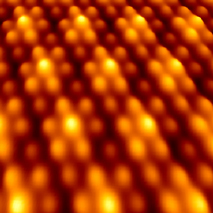Bachelor and Master thesis
We are constantly looking for Bachelor and Master students interested in surface science, who want to complete their thesis in our group. Please write a short email to Prof. Michely in case you are interested.
Confining electrons to one dimension
The celebrated electron-in-a-box represents a central problem in quantum mechanics. An experimental realization is found in grain boundaries of the two-dimensional material MoS2. Understanding, controlling, and manipulating these states helps to uncover the fundamental interactions governing there properties.
This Bachelor or Master project will involve growth and electronic characterization of grain boundaries in MoS2 and isostructural materials. Interest in quantum mechanical phenomena is welcome.
Bachelor-thesis: Electronic properties of charge density waves

A structural phase transition can occur at low temperatures when electrons strongly couple to phonons. The structural deformation is accompanied by a charge modulation in real space, which can be directly imaged with the scanning tunneling microscope. A detailed analysis of this charge modulation gives valuable information on the type of correlations responsible for the phase transition.
The Bachelor student will grow 2D materials and characterize their charge density waves at low temperatures. A basic programming knowledge is welcome, since the analysis is partly based on a python script.
Single-atom manipulation on 2D materials
This master project aims at the investigation of the electronic and magnetic properties of single atoms on 2D materials, as well as the interaction between the two. Single atoms are deposited at low temperature and moved laterally with the tip of the STM. Different scenarios, such as charge donation and spin coupling, are investigated in real space with sub-atomic precision.
The student will grow 2D materials and deposit single atoms on the cold surface of the latter. Manipulation and electronic characterization are conducted with the STM at low temperature.
Magnetic phases and interactions in cluster superlattice membranes

Cluster superlattice membranes consist of a hexagonal lattice of metal clusters embedded between a layer of graphene and a thin film of amorphous carbon. Such regular cluster arrangements should be stable against oxidation and thermal sintering.
Goals of the project are:
- growth of Fe or Co cluster superlattice membranes and demonstration that oxidation of clusters is absent. Their dipolar interactions will be investigated.
- fabrication of gadolinium membranes and investigation of the magnetic interactions of the superparamagnetic Gd clusters.
- realization of FePt clusters in the L10 phase, a ferromagnetic phase with a very high coercivity relevant in data storage.
The Bachelor or Master project will be devoted to one or several of these goals. The work will include optimization of the growth procedure for such magnetic cluster superlattice membranes using scanning tunnelling microscopy and low energy electron diffraction. The magnetic properties will be characterized through magneto optical Kerr effect and SQUID measurements, as well as X-ray circular dichroism experiments together with collaborating groups.